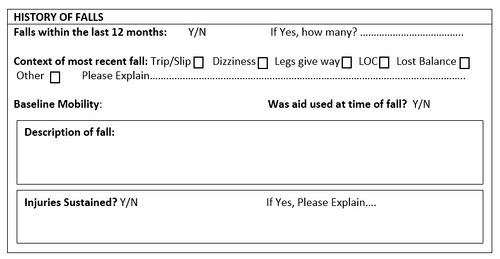The smart Trick of Dementia Fall Risk That Nobody is Talking About
Wiki Article
Excitement About Dementia Fall Risk
Table of ContentsThe Of Dementia Fall RiskDementia Fall Risk Things To Know Before You Get ThisHow Dementia Fall Risk can Save You Time, Stress, and Money.The Ultimate Guide To Dementia Fall Risk
A fall threat analysis checks to see how most likely it is that you will certainly drop. It is mostly done for older adults. The evaluation generally includes: This consists of a collection of inquiries regarding your general health and if you have actually had previous falls or problems with equilibrium, standing, and/or walking. These devices evaluate your stamina, equilibrium, and gait (the way you walk).Interventions are suggestions that might decrease your risk of falling. STEADI consists of 3 actions: you for your danger of dropping for your risk aspects that can be enhanced to try to avoid drops (for example, balance issues, impaired vision) to decrease your threat of dropping by using reliable techniques (for example, giving education and resources), you may be asked several questions including: Have you fallen in the past year? Are you stressed concerning dropping?
If it takes you 12 seconds or even more, it may indicate you are at higher danger for an autumn. This test checks toughness and balance.
Move one foot midway ahead, so the instep is touching the big toe of your various other foot. Move one foot totally in front of the other, so the toes are touching the heel of your various other foot.
Dementia Fall Risk for Beginners
The majority of drops happen as an outcome of several contributing aspects; for that reason, handling the threat of dropping starts with recognizing the variables that add to fall threat - Dementia Fall Risk. Some of one of the most pertinent threat variables include: History of previous fallsChronic medical conditionsAcute illnessImpaired gait and equilibrium, lower extremity weaknessCognitive impairmentChanges in visionCertain high-risk medications and polypharmacyEnvironmental factors can additionally raise the threat for falls, including: Poor lightingUneven or damaged flooringWet or slippery floorsMissing or damaged hand rails and grab barsDamaged or poorly fitted devices, such as beds, wheelchairs, or walkersImproper use assistive devicesInadequate guidance of individuals staying in the NF, consisting of those who exhibit hostile behaviorsA successful fall danger monitoring program requires a detailed clinical analysis, with input from all members of the interdisciplinary team

The care strategy need to likewise include interventions that are system-based, such as those that advertise a secure environment (appropriate lighting, hand rails, get hold of bars, and so on). The efficiency of the interventions need to be assessed regularly, and the care strategy changed as essential to reflect modifications in the loss danger assessment. Carrying out a fall threat monitoring system utilizing evidence-based best technique can lower the prevalence of drops in the NF, while restricting the potential for fall-related injuries.
The Greatest Guide To Dementia Fall Risk
The AGS/BGS standard suggests evaluating all adults aged 65 years and older for fall danger annually. This testing includes asking patients whether they have actually fallen 2 or more times in the past year or sought clinical interest for a fall, or, if they have not dropped, whether they really feel unstable when strolling.Individuals who have actually dropped once without injury needs to have their equilibrium and stride evaluated; those with gait or equilibrium problems ought to receive extra evaluation. A history of 1 loss without injury and without gait or balance problems does not call for more evaluation beyond continued yearly fall threat screening. Dementia Fall Risk. A fall danger evaluation is required as component of the Welcome to Medicare examination

Getting The Dementia Fall Risk To Work
Documenting a falls history is one of image source the top quality indicators for fall prevention and management. copyright medicines in particular are independent forecasters of drops.Postural hypotension can typically be relieved by decreasing the dose of blood pressurelowering medicines and/or quiting medications that have orthostatic hypotension as an adverse effects. Use of above-the-knee support tube and sleeping with the head of the bed boosted may additionally reduce postural decreases in blood stress. The recommended components of a fall-focused health examination are received Box 1.

A yank time more than or equivalent to 12 seconds suggests high autumn danger. The 30-Second Chair Stand examination examines reduced extremity strength and equilibrium. Being unable to stand up from a chair of knee elevation without using one's this website arms indicates enhanced loss risk. The 4-Stage Equilibrium test analyzes static balance by having the individual stand in 4 settings, each progressively extra challenging.
Report this wiki page